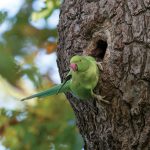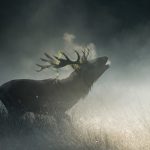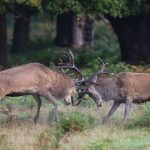Situated in the middle of London, Richmond Park may not seem like the wildest of places to go photographing wildlife. The park’s accessibility and popularity means there are a lot of people about, especially at weekends. It is however surprisingly easy to lose yourself in the woodland and be transported back to ancient times when this was a royal hunting forest.
How To Get Here
Richmond Park is in south west London, just north of Kingston-upon-Thames, with the A3 to the south of the park and the South Circular Road to the north. Parking is available by several gates.
Parking
Recommended are the Roehampton Gate (car park) and the Richmond Gate which is walking distance from Richmond Station.
Roehampton Gate
- Lat/Long: 51.453838, -0.257390
- OS map co-ordinate: TQ 211 742
- Parking Postcode: SW15 5JP
Richmond Gate
- Lat/Long: 51.450174, -0.296658
- OS map co-ordinate: TQ 184 737
- Parking Postcode: TW10 6RR
What to Shoot and Techniques
The area is a National Nature Reserve and there is an abundance of wildlife. Apart from the obvious red and fallow deer keep your eyes and ears out for green woodpeckers and increasingly abundant ring-necked parakeets.
- Nikon D800E, 300mm, ISO 6400, 1/640 sec at f/5.6. © Andrew Marshall D42_0118 – Ring-necked parakeet checking out a nest hole. Nikon D4, 500mm, ISO 1600, 1/640 sec at f/6.3. © Andrew Marshall
- Big old stag silhouetted in the misty morning light at Richmond park. © Andrew Marshall
- The clash: two red deer stags engage in combat. © Andrew Marshall
- Body heat rising from a testosterone-fuelled stag.
- Red deer stag bellowing in golden sunlight. © Andrew Marshall
Red deer (Cervus elaphus)
The red deer is the largest UK land mammal and not easy to miss. The males or stags have huge and dangerous antlers which they shed and re-grow, incredibly fast, every year. These formidable weapons are used primarily in combat to assert dominance and therefore the right to mate with the females (hinds). In autumn the stags begin to round up hinds and fend off other stags, the loud head thrown back bellowing being the initial sign that the annual rut is underway.
Warning!
Red deer are aggressive during the rut and have been known to injure and even kill people. Whilst this is unlikely and the deer here are accustomed to people it is wise to keep a safe distance or photograph from behind a tree. Watch the animal carefully. If he is eyeing you you may be in his line of attack, perhaps a young rival is behind you, be aware and alert and prepared to move quickly.
Technique
There are estimated to be around 360 red and fallow deer found throughout the park’s 2360 acres meaning there are myriad opportunities for the photographer. The time of the year, late September to October, means that early mornings can be misty and light is not always ideal. This can be a good thing too, adding further atmosphere to this medieval forest. The stags are expending massive amounts of energy roaring and chasing off rivals and are frequently steaming with body heat on cold mornings.
Light is as always of key importance and perhaps surprisingly the evening can be more rewarding than early mornings as the sun sets in the west casting low golden light on the woodland edges.
A low angle as always helps to give an idea of size however be aware that these are potentially very dangerous animals and crouching down on the ground in front of a rutting red deer is not to be advised.
The deeper woodland is a better area to capture more natural images and the sight of a red deer stag with his antlers adorned with bracken is a top shot to look out for. Again be very careful walking around in the tall bracken as the younger sub-dominant males often hide out here waiting for a chance to make a move on unguarded hinds. These stags are likely to be more dangerous with frustration having been beaten back and even possibly injured by the dominant stags.
Larger stags will often walk parallel to each other assessing each other’s size before committing to battle. The younger wannabe stags are the ones to watch for, engaged in the classic locked horn sparring.
Equipment-wise either a 300mm f/2.8 or a 500mm on a tripod is ideal for these conditions as this is a large easily approachable subject sometimes in low light conditions.
Fallow deer (Dama dama)
Present in large numbers and easy to find, the fallow deer here are reasonably tame and easy to approach. This is a very different scenario to places such as the Forest of Dean where they are timid and often elusive. The fallow deer is significantly smaller than the red and easily distinguised by its lighter, often spotted hide. Some individuals are almost white. The mature stags have a more palmate structure to the antler which looks less formidable or dangerous. Fallow deer however are nonetheless ready to use their antlers in battle and can still potentially inflict considerable damage.
Technique
With fallow deer there is little danger to life or limb so try and use a low angle to get a more dramatic shot. Take to the woods to find more naturalistic settings, the deer can be more skittish in this environment which also makes it more interesting.
Light in the woods will be either high contrast or low level so be prepared to use a high ISO if necessary. With low light the camera will require a wide aperture and consequently a shallow depth of field so make sure you focus on the eye. (Use a single focus point to make sure).
Accessibility
Aim for the car park close to Roehampton Gate where you can park for free and there are toilet facilities and a cafe. From the car park head out into the park. Be aware that a small stream crosses the middle of the grassland and you need to cross via one of the road bridges. For more information check www.royalparks.org.uk.
Best Time of Year/Day
From late September to mid October is rutting time for the huge red deer stags and this is the time to witness their exciting and impressive displays.






